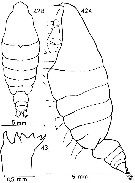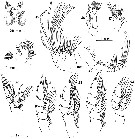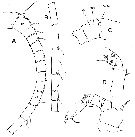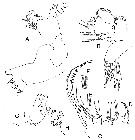|
|
 |
|
Calanoida ( Order ) |
|
|
|
Calanoidea ( Superfamily ) |
|
|
|
Megacalanidae ( Family ) |
|
|
|
Elenacalanus ( Genus ) |
|
|
| |
Elenacalanus inflatus ((Björnberg, 1968)) (F ) | |
| | | | | | | Syn.: | Bathycalanus inflatus Björnberg, 1968 (p.81, figs.F); Michel, 1994 (p.187, Rem.); Bradford-Grieve & al., 1999 (p.877, 906, figs.F);
Ref. compl.: Björnberg, 1973 (p.303, 384); Razouls & al., 2000 (p.343, tab. 3, Appendix); Park & Ferrari, 2009 (p.143, Table 3, Appendix 1, biogeography from Southern Ocean) | | | | Ref.: | | | Bradford-Grieve & al., 2017 (p.153, Redescr. F, figs.F, , fig.114, Rem., phylogeny) |  issued from : T.S.K. Björnberg in Antarctic Res. Ser., 1968, 11. [p.82, Figs.42A-B, 43]. As Bathycalanus inflatus. Female (from S Chile): 42A, habitus (lateral left side); 42B, idem (dorsal); 43, Md (masticatory edge). Nota: Head without crest, horn, or protuberance. Md with 6 teeth-like protuberances, well separated from each other, and no conspicuous median fold. Last thoracic segment not rounded but slightly angular in lateral view. The proportional lengths from head to caudal rami 41.0 : 12.3 : 9.4 : 7.9 : 5.0 : 5.0 : 7.9 : 3.6 : 2.8 : 3.6 = 100.
|
 issued from : T.S.K. Björnberg in Antarctic Res. Ser., 1968, 11. [p.83, Figs.44-54].As Bathycalanus inflatus. Female:44, lamina labialis and part of serrula, view from the pharynx; 45, Mx2; 46, A2; 47, Md (mandibular palp); 48, Mx1; 49, Mxp; 50, P1; 51. Nota: Mx2 with the ribbon-like setae not curled at the end and are shorter (2.75 times) relative to the width of the Mx2 (seen in lateral aspect) than in other species, where the ribbon-like setae are 3 or more times longer than the width of the Mx2. Mx1 with 9 setae on the 1st external lobe, no setae on the 2nd external lobe, 11 setae on the exopod, 11 or 12 bristles on the 1st internal lobe, no setae on the 2nd internal lobe, 2 setae on the 3rd 3rd internal lobe, 2 setae on the 2nd basipod, 1 seta on each of the first and second segments of endopod, and 5 setae on the terminal segment of the exopod. The endopodal lobe of Mx2 has 2 long, ribbon-like setae and 2 very short thin setae; the remaining 5 ribbon-like setae of the endopod are of the same length; there is also a shorter scythe-like seta on the endopod. Remarks: This species is included in the genus Bathycalanus because of its mouth armature and Mx1, and because the setae of Mx2 are ribbon-like, not scythe-like.
, P2; 52, P3; 53, P4; 54, P5. Bradford-Grieve & al (2017, p.156) note that the labelled as P4 in the original description in Björnberg (1968) is P2 because it has 8 setae on endopodal segment 3.
|
 Issued from : J.M. Bradford-Grieve, L. Blanco-Bercial & G.A. Boxshall in Zootaxa, 2017, 4229 (1). [p.156, Fig.108]. Female (from 40.00°N, 20.00° W): A-B, habitus (dorsal and lateral, respectively); C, rostrum (lateral); D, urosome (lateral); E, right caudal ramus (dorsoposterior view); F, P1. Scale bars: 1.0 mm (A, B, D, F); 0.1 mm (C, E). Nota: - Body of 'stout' appearance such that depth of somites in lateral view, relative to the length of the whole animal or individual somites, is greater than in other species. - Posterolateral corners, i, lateral view, of pediger 5 bluntly triangular - Urosomite 2 (Ur2)/Genital double-somite (Gns) = 0.93, where Ur2 is the midlength depth of free urosomite 2 and Gns is the posterior depth of the genital double-somite, in lateral view. - Genital double-somite approximately as wide as long, symmetrical in dorsal view. - In lateral view dorsal and ventral profile of urosomites 2 and 3 convex. - P1 basis inner distal seta curved along distal border of endopodal segment 1; exopodal segment 3 with proximal outer spine not extending as far as base of distal outer spine.
|
 Issued from : J.M. Bradford-Grieve, L. Blanco-Bercial & G.A. Boxshall in Zootaxa, 2017, 4229 (1). [p.157, Fig.109]. Female: A, A1, ancestral segments I-XIV; B, A1, ancestral segments XV-XVIII; A, ancestral segments I-IV (dorsal view); D, A2. Scale bars: 1.0 mm (A-C); 0.1 mm (D). Nota: - A1 broken, ancestral segments I-XVIII, only available. Dorsal surface if ancestral segments I, II and III, only, with dorsal surface hair sensillum and adjacent macula cribrosa. - A2 exopod ancestral segment IV without seta.
|
 Issued from : J.M. Bradford-Grieve, L. Blanco-Bercial & G.A. Boxshall in Zootaxa, 2017, 4229 (1). [p.158, Fig.110]. Female: A, Md; B, Mx1; C, Mx2 praecoxal to basal endites; D, detail of small seta of praecoxal endite 2; E, detail of longest seta on coxal endite 1; F, detail of distal seta of basal endite; G, Mx2 endopod and basal endite (lateral view); H, Mx2 endopod (inner view). Scale bars: 1.0 mm (G, H); 0.1 mm on remaining figures. Nota: - Md basis with all 4 setae inserted on distal inner border; that is, proximalmost seta inserted well distal to midlength of basis inner border. - Mx1 praecoxal arthrite with 13 setae including 2 on posterior surface; coxal endite without setae; basal endites 1 and 2 each with 2 setae; endopod segments with 1, 1, 4+1 anterior surface seta; basal exite without seta; epipodite with 7 long and 1 vestigial setae. - Mx2 terminal setae only slightly curved distally.
|
 Issued from : J.M. Bradford-Grieve, L. Blanco-Bercial & G.A. Boxshall in Zootaxa, 2017, 4229 (1). [p.159, Fig.111]. Female: A, Mxp; B, detail of small seta on syncoxal endite 2 of Mxp; C, detail of terminal seta on endopod segment 6 showing long fine setules along concave border; D, P2; E, P3; F, P4; G, P5. Scale bars: 1.0 mm (A, C-F); 0.1 mm (B). Nota: - Mxp syncoxal (= a double segment derived from fusion of praecoxa and coxa) endite 4 longest seta extends to distal border of endopodal segment 1; endopodal segments 3-6 with 1, 1, 1, 4 setae (2 large and 2 very small), respectively.
|
 Issued from : J.M. Bradford-Grieve, L. Blanco-Bercial & G.A. Boxshall in Zootaxa, 2017, 4229 (1). [p.91, Table 11]. Morphological characters after identification key of Elenacalanus females and males. Compare to other species of genus. Main characters identification after species key : 1 - Head without crest. 2 - Mx1 basal endite 2 with 2 setae. 3 - Md basis proximalmost seta placed distal to midlength of inner border. (male unknown)
| | | | | NZ: | 4 | | |
|
Distribution map of Elenacalanus inflatus by geographical zones
|
| | | | | | | Loc: | | | Antarct. (Drake Passage, Scotia Sea), sub-Antarct. (SE Pacif.); NE Atlant. (off E Azores)
Type locality: 56°06'S, 71°14'W.
| | | | N: | 4 | | | | Lg.: | | | (406) F: 13,85-13,6; (1316) F: 12,4-13,5; {F: 12,4-13,85} | | | | Rem.: |
Sampling depth (Antarct., sub-Antarct.) : 1000-2000 m. Sampling depth in Björnberg (1968): 983 m (Drake Passage), 1867 m (Scotia Sea); 990-1280 m; NE Atlant.: 990-1250 m.
For Bradford-Grieve & al (2017, p.156) this species is very like E. princeps and E. tageae in that all three species have 2 setae on basal endite 2 of Mx1 and the posterolateral corners of pedigerous somite 5 are blunty triangular. E. inflatus is distinguished by the distal placement of the four setae of the basis of the Md, and the setae on the terminal part of the Mx2 which are hardly curved. The authors suggest that the species may possibly be distinguished from other Elenacalanus by the ratio between the deptjh at midlength of free urosomite 2 (Ur2) and the posterior depth of the genital double-somite (Gns): Gns / Ur2 = 0.93 (this ratio from a single specimen of E. princeps = 0.76, E. eltaninae = 0.85, and E. tageae = 0.86. | | | Last update : 19/06/2023 | |
|
|
 Any use of this site for a publication will be mentioned with the following reference : Any use of this site for a publication will be mentioned with the following reference :
Razouls C., Desreumaux N., Kouwenberg J. and de Bovée F., 2005-2025. - Biodiversity of Marine Planktonic Copepods (morphology, geographical distribution and biological data). Sorbonne University, CNRS. Available at http://copepodes.obs-banyuls.fr/en [Accessed December 01, 2025] © copyright 2005-2025 Sorbonne University, CNRS
|
|
 |
 |








